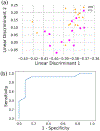Fluorescence and Multiphoton Imaging for Tissue Characterization of a Model of Postmenopausal Ovarian Cancer
- PMID: 32311117
- PMCID: PMC7572562
- DOI: 10.1002/lsm.23251
Fluorescence and Multiphoton Imaging for Tissue Characterization of a Model of Postmenopausal Ovarian Cancer
Abstract
Background and objectives: To determine the efficacy of targeted fluorescent biomarkers and multiphoton imaging to characterize early changes in ovarian tissue with the onset of cancer.
Study design/materials and methods: A transgenic TgMISIIR-TAg mouse was used as an animal model for ovarian cancer. Mice were injected with fluorescent dyes to bind to the folate receptor α, matrix metalloproteinases, and integrins. Half of the mice were treated with 4-vinylcyclohexene diepoxide (VCD) to simulate menopause. Widefield fluorescence imaging (WFI) and multiphoton imaging of the ovaries and oviducts were conducted at 4 and 8 weeks of age. The fluorescence signal magnitude was quantified, and texture features were derived from multiphoton imaging. Linear discriminant analysis was then used to classify mouse groups.
Results: Imaging features from both fluorescence imaging and multiphoton imaging show significant changes (P < 0.01) with age, VCD treatment, and genotype. The classification model is able to classify different groups to accuracies of 75.53%, 69.53%, and 86.76%, for age, VCD treatment, and genotype, respectively. Building a classification model using features from multiple modalities shows marked improvement over individual modalities.
Conclusions: This study demonstrates that using WFI with targeted biomarkers, and multiphoton imaging with endogenous contrast shows promise for detecting early changes in ovarian tissue with the onset of cancer. The results indicate that multimodal imaging can provide higher sensitivity for classifying tissue types than using single modalities alone. Lasers Surg. Med. © 2020 Wiley Periodicals, Inc.
Keywords: fluorescence imaging; multiphoton imaging; ovarian cancer.
© 2020 Wiley Periodicals, Inc.
Conflict of interest statement
Disclosures
We have no relevant financial interests and no other potential conflicts of interest to disclose.
Figures






References
-
- Siegel Rebecca L, Miller Kimberly D, Jemal Ahmedin. Cancer statistics, 2019. CA: a cancer journal for clinicians. 2019. - PubMed
-
- Noone AM, Howlader N, Krapcho M, et al. Cancer Statistics Review, 1975–2015 - SeEr Statistics 2018.
-
- Camille Maringe, Sarah Walters, John Butler, et al. Stage at diagnosis and ovarian cancer survival: Evidence from the international cancer benchmarking partnership Gynecol. Oncol. 2012;127:75–82. - PubMed
Publication types
MeSH terms
Grants and funding
LinkOut - more resources
Full Text Sources
Medical

